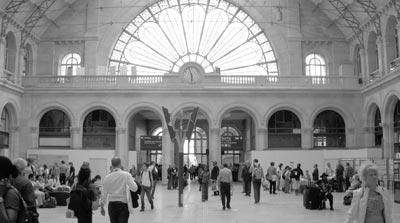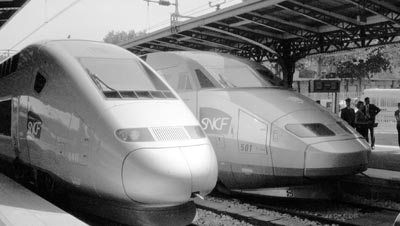TGV Est Premiére
by Jay Brunhouse
It is through flat, green, French countryside surrounded by fields of grain that my TGV train really flexed its muscles. Powering ahead, I didn’t feel any curves, and when I encountered slightly rolling hills, raw embankments rose high above my window. The level ride over the new Est européene line was so smooth (TGVs are the smoothest- riding trains in Europe) that I was quite startled when I suddenly heard the announcement.
“You are now traveling at 320 kilometers per hour” (199 mph). My TGV had departed from Paris’ renovated Gare de l’Est Station at 6:35 a.m. on June 9, 2007, while the sun was trying to peek through rolling, dark clouds. After a few publicity stops at new TGV stations, we arrived in Strasbourg for the celebration and launch of the new Est line, and in the midst of lightning and pounding rain a cabinet minister delivered an eloquent speech. I consider this a journalistic hazard.
True, the tents of the exhibits of FrenchRail’s (SNCF’s) partners of the TGV Est provided shelter. GermanRail (DB), Luxembourg and the cities and regions financially supported the line’s construction based on a formula accounting for the time savings for travelers to Paris.
The new line runs from Vairessur- Marne outside of Paris until Baudrecourt in the Moselle nearing Strasbourg. At this point, the region becomes forested and my train slowed to 100 mph over old tracks. I noticed some bumpiness.
The TGV Est network
TGV Est network cuts train travel time by one-third to one-half between 20 destinations in France as well as between Paris and 10 destinations in Germany, Switzerland and Luxembourg. The frequency of service increased by 15%-20% along the new line, which runs from Paris east through the Champagne, Lorraine and Alsace regions of France, serving cities such as Reims, Nancy, Metz and Strasbourg.
The new line also provides faster train connections from eastern France to other regions — to cities such as Lille, Bordeaux and Nantes and between Charles de Gaulle Airport and Strasbourg.
Rail now offers the shortest travel time, city center to city center, between Paris and Frankfurt or Stuttgart and will compete with Frankfurt’s 30 daily fl ights on the basis of comfort and price.
Renewed Reseau
Once aboard the TGVs over the Est line, one would never believe that the carriages date from 1993, when SNCF placed in service its third-generation TGV-R (“R” for “reseau,” or network) trains on its TGV Nord high-speed line from Paris to Brussels and to Calais at the entrance to the Channel Tunnel. The multivoltage TGV POS power cars look, at a glance, like the original TGV SE trains between Paris and Lyon, but they are shorter, generally run in pairs, and incorporate a more powerful transformer and higher-capacity engine. The change in profi les of the power cars makes them look like sharks with backpacks.
Designer Christian Lacroix created a new interior design for the TGV Est trains using original shapes and colors. He provided more individual comfort throughout the train with ergonomic reclining seats, headrests and footrests, plus luggage racks within the carriages. He removed seats in second class to provide more leg space and added individual electrical outlets in first class.
On the German side
What a novelty it is to see a German ICE 3MF train parked in a French train station — and in Paris, the heart of the French network! But SNCF and DB are collaborating on what they feel will be the heart of the coming international high-speed network.
DB readied six of the dual-voltage ICE 3MF (“MF” for Multi-voltage France) for service between Germany and Paris capable of using both German and French electrical systems at 199 mph, the same speed as the French TGVs. One ICE 3MF train pair runs from Frankfurt/Main via Mannheim and Saarbrücken to Paris, complemented by two additional ICE 3MF train pairs between
Saarbrücken and Paris with a connection to Frankfurt/Main. Beginning on Dec. 9, DB will send five ICE 3MF through train pairs between Paris and Frankfurt/Main. The stretch between Mannheim and Saarbrücken will be upgraded to 125 mph and the Saarbrücken train station will have been rebuilt and modernized into a “Eurobahnhof.”
First-class service includes a choice of daily newspapers, a taxi reservation service for Paris and a light meal served at your seat. German and French staff share duties on board.
World speed record
The new Est line achieved headline news status this year when an SNCF TGV broke the standing world speed record of 320.3 mph set in May 1990 for steel-wheel-on-steel-rail trains. (In 2003, Japan’s maglev train set the speed record for noncontact trains at 361 mph.)
In an attempt to shatter the record, SNCF performed a series of highspeed trials over the Est line prior to its June inauguration. Following increasingly high-speed runs between Jan. 15 and April 15, the official speed record attempt took place on April 3. The TGV reached the top speed of 357.2 mph near the village of Le Chemin, between the Meuse and Champagne-Ardenne TGV stations, where the most favorable profile exists.
The train used for the speed record was code-named V150 and comprised three modified TGV Duplex (doubledecked) cars, which normally run on the TGV Mediterranean line. It was fitted with larger wheels and a 25,000- horsepower engine — double the power of a conventional TGV. Track and catenary were also modified and closely monitored during the tests. An Aérospatiale Corvette airplane chased the train to provide data relay and uplink of live television images.
Gare de l’Est
Paris’ Gare de l’Est is the chosen terminus for the TGV Est trains. When you rise on sparkling escalators from the Paris Métro into the station’s new reception hall, you will be surprised at the transformation of the formerly dowdy station into the bright terminus of France’s newest TGV line. Even after enlargement, it is still fourth largest of Paris’ six terminuses and uncluttered despite offering all amenities, including auto rental agencies.
The Est station looks new but traditional, and it has a new luster, but the sparrows flitting in and out and about haven’t changed. When SNCF announced they were going to renovate the station with a new wing, new escalators and new decorations to become the terminus for the TGV Est, there was an outcry from residents of the Gallic city: “Protect our sparrows. They are family.” I thank Rail Europe (888/382-7245, www.raileurope.com) for arranging my invitation to the launch of the TGV Est, for providing a 4-day France Railpass and for making seat reservations.



